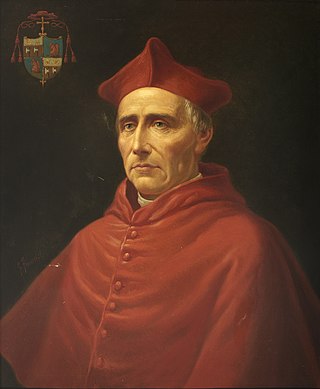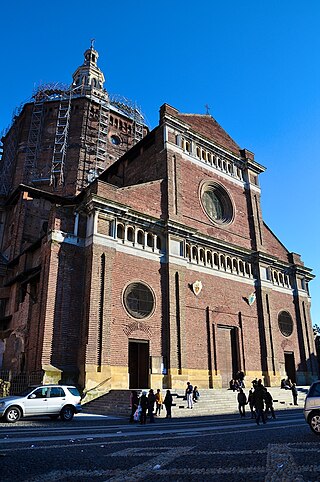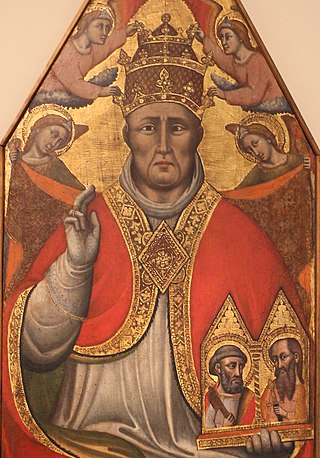
Year 1304 (MCCCIV) was a leap year starting on Wednesday of the Julian calendar.

The Latin Patriarchate of Jerusalem is the Latin Catholic ecclesiastical patriarchate in Jerusalem, officially seated in the Church of the Holy Sepulchre. It was originally established in 1099, with the Kingdom of Jerusalem encompassing the territories in the Holy Land newly conquered by the First Crusade. From 1374 to 1847 it was a titular see, with the patriarchs of Jerusalem being based at the Basilica di San Lorenzo fuori le Mura in Rome. A resident Latin patriarch was re-established in 1847 by Pius IX.
Michael Northburgh, otherwise Michael de Northburgh (Northborough), was the Bishop of London between 1354 and his death in 1361. He was the nephew of Roger Northburgh, Bishop of Coventry and Lichfield.

The Patriarch of Venice is the ordinary bishop of the Archdiocese of Venice. The bishop is one of only four patriarchs in the Latin Church of the Catholic Church. The other three are the Patriarch of Lisbon, the Patriarch of the East Indies and the Latin Patriarch of Jerusalem. Presently, the only advantage of this purely formal title is the bishop's place of honor in papal processions. In the case of Venice, an additional privilege allows the patriarch, even if he is not a cardinal, the use of the colour red in non-liturgical vestments. In that case, the red biretta is topped by a tuft, as is the custom with other bishops who are not cardinals.

The Latin Patriarchate of Alexandria was a nominal patriarchate of the Latin church on the see of Alexandria in Egypt.

Christopher Bainbridge was an English cardinal. Of Westmorland origins, he was a nephew of Bishop Thomas Langton of Winchester, represented the continuation of Langton's influence and teaching and succeeded him in many of his appointments such as provost of The Queen's College in the University of Oxford. Towards the end of the reign of King Henry VII, he was successively Master of the Rolls, a Privy Counsellor, Dean of Windsor and Bishop of Durham. Becoming Archbishop of York and therefore Primate of England in 1508, he was sent as procurator of King Henry VIII to the papal court of Pope Julius II, where he was active in the diplomatic affairs leading to Henry's war against France and took part in the election of Julius's successor, Pope Leo X. He was murdered by poisoning in Italy in 1514 and was succeeded as Archbishop of York by Thomas Wolsey.
Alexander Neville was a late medieval prelate who served as Archbishop of York from 1374 to 1388.
Geraldus Odonis, Guiral Ot in Occitan, was a French theologian and Minister General of the Franciscan Order.

The Diocese of Faenza-Modigliana is a see of the Catholic Church in Italy. It was created in 1986 through a merger of the diocese of Faenza and the diocese of Modigliana.
Annibaldo Caetani di Ceccano was an Italian Cardinal. His palace, the Livrée Ceccano at Avignon, begun in about 1335/1340, still survives; it is now a public library.

The Diocese of Pavia is a see of the Catholic Church in Italy. It has been a suffragan of the Archdiocese of Milan only since 1817. Previous to the reorganization of the hierarchy in northern Italy by Pope Pius VII after the expulsion of the French and the Congress of Vienna, the diocese of Pavia had depended directly upon the Holy See, despite repeated failed attempts on the part of the Archbishops of Milan to claim control. The diocese has produced one Pope and Patriarch of Venice, and three cardinals.

Richard Mitford was an English bishop of Chichester from 17 November 1389, consecrated on 10 April 1390, and then bishop of Salisbury. He was translated to the see of Salisbury on 25 October 1395.

Pierre Desprès (1288–1361) was a French Cardinal during the period of the Avignon Papacy.

The Custody of the Holy Land is a custodian priory of the Order of Friars Minor in Jerusalem, founded as the Province of the Holy Land in 1217 by Saint Francis of Assisi, who had also founded the Franciscan Order in 1209. In 1342, the Franciscans were declared by two papal bulls as the official custodians of the Holy Places in the name of the Catholic Church.
Henry Cole was a senior English Roman Catholic churchman and academic.

Audouin Aubert was a French jurist, bishop and Cardinal.

A papal conclave was held between 22 September and 28 October 1362 in the Palais des Papes of Avignon to elect the successor of Pope Innocent VI. Guillaume de Grimoard was elected pope and took the name Urban V.
Thomas Fastolf, sometimes spelt Fastolfe, was an English canon lawyer and Bishop of St David's from 1352 until his death.
Robert de Stretton was Bishop of Coventry and Lichfield following the death of Roger Northburgh in 1358. A client of Edward, the Black Prince, he became a "notorious figure" because it was alleged that he was illiterate, although this is now largely discounted as unlikely, as he was a relatively efficient administrator.
Fulgenzio Manfredi, OFM, or Fra Fulgenzio, was a Franciscan friar, an observant minor, and active preacher in Venice from 1594. During the Venetian Interdict imposed by Pope Paul V, he gained particular prominence for his anti-Roman sermons, preaching against papal regulation of religious orders in the Venetian republic.











